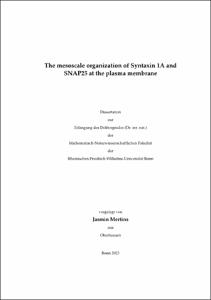Mertins, Jasmin: The mesoscale organization of Syntaxin 1A and SNAP25 at the plasma membrane. - Bonn, 2023. - Dissertation, Rheinische Friedrich-Wilhelms-Universität Bonn.
Online-Ausgabe in bonndoc: https://nbn-resolving.org/urn:nbn:de:hbz:5-69673
Online-Ausgabe in bonndoc: https://nbn-resolving.org/urn:nbn:de:hbz:5-69673
@phdthesis{handle:20.500.11811/10686,
urn: https://nbn-resolving.org/urn:nbn:de:hbz:5-69673,
author = {{Jasmin Mertins}},
title = {The mesoscale organization of Syntaxin 1A and SNAP25 at the plasma membrane},
school = {Rheinische Friedrich-Wilhelms-Universität Bonn},
year = 2023,
month = mar,
note = {The plasma membrane is a highly crowded place consisting of a plethora of proteins and lipids, which show a high degree of micropatterning. Most proteins are not homogeneously distributed but concentrated in clusters. Moreover, clusters of different proteins group together by a yet not understood mechanism.
The two classical SNARE-proteins Syntaxin 1A and SNAP25 are one example of such proteins. Together with Synaptobrevin, they are known to catalyze neuronal exocytosis. Even though they need to form complexes for this process, they are largely segregated in the plasma membrane. Syntaxin 1A is concentrated in clusters, occupying only a small part on the plasma membrane. The more abundant SNAP25 on the other hand can be found in rather large, more widespread crowds. The cytosolic protein Munc18-1 is a key regulator of neuronal exocytosis and binds tightly to Syntaxin 1A.
In this study, we wanted to determine the relationship between Syntaxin 1A clusters and SNAP25 crowds at the plasma membrane of PC12 cells. To this end, we combined quantitative western blot for stoichiometric analysis, epitope accessibility to probe for molecule crowding and high-resolution microscopy to localize protein clusters/crowds.
Furthermore, using epifluorescence and high-resolution microscopy, we found that Syntaxin 1A is capable to redistribute the more abundant SNAP25 crowds on the plasma membrane. In particular, raising the Syntaxin 1A concentration at the plasma membrane lead to an expected increase in its cluster size and number on the membrane, whereas SNAP25 crowds interestingly became darker and more clustered. A Syntaxin 1A deletion variant where the N-terminal part of the SNARE-motif was deleted did not show this effect.
By comparing different SNAP25 deletion variants we could further determine that the N-terminal motif of SNAP25 was the main facilitator of interaction with Syntaxin 1A.
We conclude that Syntaxin 1A clusters and SNAP25 crowds group together (organizing on the mesoscale) via a SNARE-SNARE-motif interaction.
Additionally, the effect of Munc18-1 on the mesoscale distribution of SNARE-proteins was analyzed as well. Experiments using recombinant Munc18-1 showed binding towards Syntaxin 1A, yet we could not detect any significant effect on the mesoscale distribution of the two SNARE-proteins.
All in all, in this study we showed that the SNARE-motif not only play an important role in the fusion of membranes, yet it also facilitates a strong protein-protein interaction which is capable organizing Syntaxin 1A clusters and SNAP25 crowds at the plasma membrane.},
url = {https://hdl.handle.net/20.500.11811/10686}
}
urn: https://nbn-resolving.org/urn:nbn:de:hbz:5-69673,
author = {{Jasmin Mertins}},
title = {The mesoscale organization of Syntaxin 1A and SNAP25 at the plasma membrane},
school = {Rheinische Friedrich-Wilhelms-Universität Bonn},
year = 2023,
month = mar,
note = {The plasma membrane is a highly crowded place consisting of a plethora of proteins and lipids, which show a high degree of micropatterning. Most proteins are not homogeneously distributed but concentrated in clusters. Moreover, clusters of different proteins group together by a yet not understood mechanism.
The two classical SNARE-proteins Syntaxin 1A and SNAP25 are one example of such proteins. Together with Synaptobrevin, they are known to catalyze neuronal exocytosis. Even though they need to form complexes for this process, they are largely segregated in the plasma membrane. Syntaxin 1A is concentrated in clusters, occupying only a small part on the plasma membrane. The more abundant SNAP25 on the other hand can be found in rather large, more widespread crowds. The cytosolic protein Munc18-1 is a key regulator of neuronal exocytosis and binds tightly to Syntaxin 1A.
In this study, we wanted to determine the relationship between Syntaxin 1A clusters and SNAP25 crowds at the plasma membrane of PC12 cells. To this end, we combined quantitative western blot for stoichiometric analysis, epitope accessibility to probe for molecule crowding and high-resolution microscopy to localize protein clusters/crowds.
Furthermore, using epifluorescence and high-resolution microscopy, we found that Syntaxin 1A is capable to redistribute the more abundant SNAP25 crowds on the plasma membrane. In particular, raising the Syntaxin 1A concentration at the plasma membrane lead to an expected increase in its cluster size and number on the membrane, whereas SNAP25 crowds interestingly became darker and more clustered. A Syntaxin 1A deletion variant where the N-terminal part of the SNARE-motif was deleted did not show this effect.
By comparing different SNAP25 deletion variants we could further determine that the N-terminal motif of SNAP25 was the main facilitator of interaction with Syntaxin 1A.
We conclude that Syntaxin 1A clusters and SNAP25 crowds group together (organizing on the mesoscale) via a SNARE-SNARE-motif interaction.
Additionally, the effect of Munc18-1 on the mesoscale distribution of SNARE-proteins was analyzed as well. Experiments using recombinant Munc18-1 showed binding towards Syntaxin 1A, yet we could not detect any significant effect on the mesoscale distribution of the two SNARE-proteins.
All in all, in this study we showed that the SNARE-motif not only play an important role in the fusion of membranes, yet it also facilitates a strong protein-protein interaction which is capable organizing Syntaxin 1A clusters and SNAP25 crowds at the plasma membrane.},
url = {https://hdl.handle.net/20.500.11811/10686}
}






